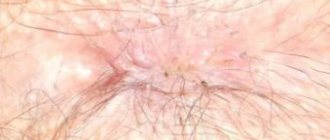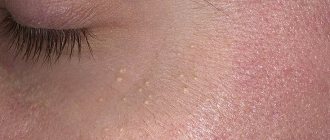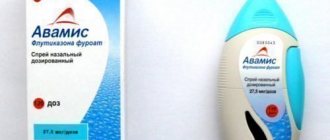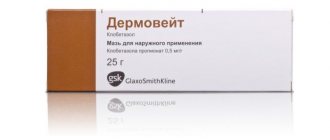.
A boil on the tailbone is, without a doubt, a painful phenomenon and causes great discomfort, because the tailbone is a delicate and important part of the body - muscles are attached to it and nerve endings are hidden in it. A boil, although it is simply an irritating inflammation that usually goes away on its own, can lead to complications. A boil is sometimes confused with other sores, which can be more or less dangerous, so it is important to accurately identify the disease. A doctor can help cure a boil with medication or surgery. Traditional methods will also help with boils. Let's look at the main causes.
The tailbone contains many nerve endings, so boils on it are very painful
Causes of neoplasms in the back area
A furuncle (popularly called a “boil”) is a very large, painfully inflamed pimple with a large purulent core inside. Often, having cured one boil, the patient breathes a sigh of relief. However, it is too early to rejoice: almost always furunculosis forces the patient to treat recurring boils again and again.
Why do boils appear on the tailbone? The fact is that the back, in particular the lower back, is an area of the body that is often exposed to drafts. As a result of decreased immunity, a person may suffer from furunculosis, which requires complex treatment. A bruised tailbone from a fall is another factor that can lead to damage to the skin and the subsequent appearance of boils.
It is necessary to distinguish between the forms of dermatological pathologies. Some patients complain of acne appearing on the tailbone. Sometimes this happens due to insufficient hygiene of the thale. A furuncle is a kind of small but deep hole on the tailbone, which is filled with a purulent core. Until it is removed, the tissue will become inflamed, and the patient will suffer from pain, swelling and burning. However, sometimes the condition can be identified by a specialist as a fistula or other pathology.
Causes and symptoms
An abscess on the tailbone occurs for various reasons, but the main doctors identify the following:
- Atheroma is most often characteristic of those people who lead an active lifestyle and play sports. Excessive physical stress on the lower back causes profuse sweating, which in turn leads to clogged sebaceous glands.
- Congenital predisposition - chronic purulent processes form in the area of the epithelial covering of the coccyx. Primary symptoms occur already in adolescence. Treatment of this pathology is possible only with the help of surgery by excision of the problem area.
It should be noted that men are 10 times more likely to develop boils on the tailbone than women. This can be explained by the greater presence of hair follicles in this area and more intense sweating. The disease is also considered seasonal - the number of patients increases in the spring and autumn. Reasons contributing to the development of the inflammatory process and the appearance of abscesses include:
- tight clothes and tight elastic bands;
- hypothermia;
- unprofessional hair removal;
- microtraumas and cracks;
- chronic fatigue and stress;
- overweight;
- disturbances in the digestive tract;
- poor nutrition.
Symptoms of the disease directly depend on the stage of development, of which there are only three:
- At the first stage, a dense small tubercle appears on the skin, in which inflammation develops and an internal infiltrate is formed. The affected area experiences a burning sensation, pain when touched, and constant tingling. Over time, these symptoms intensify, and the swelling spreads to a wider area. This stage is called the infiltration stage and lasts about three days.
- The boil matures and a necrotic core forms in it. Its dimensions can reach three centimeters. At this stage it takes on a cone shape. The pain becomes intense, often accompanied by fever, headache, nausea, general malaise and loss of appetite.
- The last stage is associated with the breakthrough of the abscess and the opening of the boil. If necessary, this process can be accelerated through surgery. Purulent contents mixed with blood come out of the wound. After the breakthrough, the inflammation subsides, the pain decreases, and a depression appears at the site of the boil, which heals over several days. If the abscess is large enough, there is a risk that a noticeable scar will remain.
Why is it dangerous?
The main danger of furunculosis is that if the pus does not find a way out, it can go inside. If the pus on the tailbone rushes inward, and the boil does not “break through” the skin from the outside, then the patient can face many complications: from sepsis to problems with the nervous system.
The easiest way to protect yourself from the possible consequences of furunculosis is to visit a dermatologist. Using a disinfected scalpel, an incision was made and the purulent root was completely removed with a special spoon. After treatment, you will need to take immunomodulatory drugs to prevent relapse of furunculosis. Treat the wound with medical alcohol or Chlorhexidine. If the patient has suffered a severe bruise to the tailbone due to a fall, treatment should also include an X-ray or CT scan to ensure that the spinal cord is not damaged. The pictures are also good in that they allow you to make sure that the pus from the boil has not gone into the bone tissue.
Symptoms and development of boils
Boils form in several stages:
- First there is redness, painful and itchy. The formation of a boil is accompanied by a loss of strength in the patient and fever.
- After 2–3 days the head is formed.
- After a week, the boil ripens and the pus comes out. At this stage, carefully remove the rod and disinfect the wound. The wound then scars.
Boils usually go away on their own, but complications also often occur. It may happen that the pus goes into the surrounding tissue and infects the blood. There are also cases when a corbuncle is formed. A furuncle, unlike a corbuncle, forms around one hair follicle and has only one head.
Another characteristic feature: a regular boil is easier to cure, you can even do it yourself, but a corbuncle is accompanied by fever and requires serious treatment. Furunculosis is a disease that manifests itself in the form of many boils on the skin in different parts of the body.
There are several ways to speed up or remove a boil.
After the purulent core comes out, the wound should be thoroughly disinfected
Rules for treating neoplasms
Often patients do not want to see a doctor and are afraid of surgery. Despite the fact that a small operation to remove the purulent root (the intervention does not even require anesthesia, but doctors often accommodate the patient and inject the area with an anesthetic) is the fastest and safest way to get rid of a boil, patients prefer treatment with ointments.
Rules that should not be violated when trying to treat a boil on the tailbone at home:
- During procedures, hands should be thoroughly washed with soap and dried with a clean towel;
- all instruments used for dressing procedures must be clean;
- pharmacological drugs used in treatment must be of high quality - not expired, the packaging must not be damaged;
- If there is no result of treatment after two or three days, you should still consult a doctor.
Treatment with medications
If disturbing symptoms appear, the best solution is to immediately consult a doctor. After the examination, he will prescribe medications, usually ointments, that will speed up the formation of the boil. After the boil opens and releases pus, the wound will have to be treated with disinfectants for some time in order to prevent a relapse.
If after examination the doctor sees a complication, the boil is removed surgically. The operation takes place under anesthesia and does not last long: the surgeon makes an incision, removes the pus, and then the wound is coated with medicine. Boils can be effectively removed using traditional methods, but no matter what method is chosen, it is important not to introduce an infection into the wound and not make the matter worse. During treatment you cannot:
- Soak the boil in water.
- Touch boils with your hands, especially dirty ones.
- Try to squeeze out or puncture the boil.
If these precautions are not followed, you may accidentally introduce an infection inside and cause blood poisoning or other complications. Although a boil is a common condition and is not fatal, the complication can be fatal.
Aloe leaf - a folk remedy for boils
List of anti-inflammatory and antibiotic ointments
The most popular pharmaceutical ointments, which are inexpensive, but do not lose their effectiveness:
- Ichthyol ointment.
- Heparin ointment.
- Vishnevsky ointment.
- "Gyoksizon".
- "Levomekol".
Which ointment should I choose - one with an antibiotic, one with hormones, or a regular anti-inflammatory agent? The main goal in treating a boil on the coccyx is to “pull out” its shaft completely as quickly as possible, while avoiding inflammation and suppuration of nearby tissues. Therefore, it is advisable to use both antibacterial and anti-inflammatory ointments in turn. In addition, many patients, in parallel with pharmaceutical products, use centuries-old traditional medicine recipes. This integrated approach allows you to get rid of the boil in a couple of days and prevent the subsequent formation of abscesses.
The difference between a boil and a carbuncle
A carbuncle and a furuncle have several obvious differences, knowing which it is difficult to confuse these two neoplasms. A boil is a single independent suppuration localized around the hair follicle. Carbuncles are damage to several hair follicles at the same time.
Also, boils are treated in a regular clinic, with the exception of multiple lesions (furunculosis) and in the absence of possible complications. The carbuncle must be treated in a hospital, since the course of this pathology is considered complex: the patient develops a high fever, develops a febrile state, and possible intoxication of the body. Antibiotics are used to treat carbuncles, which is not necessary to treat boils.
Compresses for boils with Dimexide
“Dimexide” is a solution that is used for burns, festering wounds, and boils. It provides a local warming effect and also promotes deeper penetration of the therapeutic components of the compress into the tissue. Step-by-step instructions for using the product:
- Wash your hands before applying the compress. Prepare honey, Dimexide and a clean cotton pad, as well as a piece of adhesive plaster.
- Blot a cotton pad with Dimexide. Wipe the area of skin on the tailbone with the boil. Apply a thin layer of honey - this will help reduce the degree of inflammation, reduce the severity of pain and burning, and also speed up the process of removing the purulent root out.
- Cover the boil with a soaked cotton pad and secure with adhesive tape.
- Leave the compress for half an hour. Monitor your well-being: in some patients, the solution provokes a burn. If the skin gets sore, it is better to immediately wash off the remaining compress with warm water and not try this method again.
Ichthyol ointment
Ichthyol ointment is an inexpensive product that has an anti-inflammatory, disinfectant, and analgesic effect. Also, compresses with this ointment will help draw out the purulent core faster.
The disadvantages of the product are a strong unpleasant odor, which is caused by the presence of sulfur in the composition. A bandage with ointment can be applied three times a day; you can alternate the use of ointment with antibacterial agents. It is not recommended to use ointment with ichthyol for children under six years of age. The drug costs from 90 to 130 rubles.
Heparin ointment
Heparin ointment has a very versatile effect. With regular use, it prevents the formation of blood clots, relieves local inflammation, and eliminates pain. When using compresses on the boil area, it accelerates the ripening period.
A boil on the coccyx in men, as a rule, takes the same amount of time to mature as in women - 3-6 days in the absence of treatment and 1-3 days with regular complex treatment.
It is good to combine the use of heparin ointment with the use of antibacterial ointments (tetracycline, Levomekol). You can even combine them directly together, since the effect of heparin ointment improves the ability to absorb the antibiotic components of other ointments.
Heparin ointment is not used in the presence of ulcerative processes, decreased blood clotting, or for pregnant women.
Consultation with a proctologist
Pathology in the form of the epithelial coccygeal tract occurs only in men. The frequency of diagnosis of this disease is quite high - 1 case per 300-400 boys born. At a younger age, a pilonidal cyst may not cause inconvenience and may not manifest itself in any way. However, from the onset of puberty and beyond, it is difficult to ignore the disease.
At the appointment, the proctologist diagnoses an uncomplicated epithelial coccygeal tract during a visual examination; a symptom confirming the pathology is holes in the fold between the buttocks. If, along with this, local inflammation is detected and fistula tracts are noticeable, the proctologist can diagnose a complicated pilonidal cyst. Also during the consultation, the proctologist performs a digital examination aimed at excluding other pathologies. In particular, it is necessary to ensure that there are no changes in the area of the Morganian crypts - anatomical depressions in the terminal segment of the rectum, as well as in the area of the coccygeal and sacral vertebrae.
Application of Vishnevsky ointment
How to quickly cure a boil on the tailbone in men or women? It’s worth trying Vishnevsky’s ointment (the full name is “Balsamic Liniment according to Vishnevsky”). This product contains tar and xeroform. These components help relieve swelling, provide a slight anti-edematous effect, and accelerate the maturation of the boil, regardless of its location.
Dermatologists recommend applying a thin layer of ointment to the affected area around the boil two to three times a day. In this case, it is not necessary to make a compress or bandage; the ointment is absorbed quite quickly by the tissues. Contraindication for use: allergies or intolerance to tar.
Causes and symptoms
An abscess on the tailbone occurs for various reasons, but the main doctors identify the following:
- Atheroma is most often characteristic of those people who lead an active lifestyle and play sports. Excessive physical stress on the lower back causes profuse sweating, which in turn leads to clogged sebaceous glands.
- Congenital predisposition - chronic purulent processes form in the area of the epithelial covering of the coccyx. Primary symptoms occur already in adolescence. Treatment of this pathology is possible only with the help of surgery by excision of the problem area.
It should be noted that men are 10 times more likely to develop boils on the tailbone than women. This can be explained by the greater presence of hair follicles in this area and more intense sweating. The disease is also considered seasonal - the number of patients increases in the spring and autumn. Reasons contributing to the development of the inflammatory process and the appearance of abscesses include:
- tight clothes and tight elastic bands;
- hypothermia;
- unprofessional hair removal;
- microtraumas and cracks;
- chronic fatigue and stress;
- overweight;
- disturbances in the digestive tract;
- poor nutrition.
Symptoms of the disease directly depend on the stage of development, of which there are only three:
- At the first stage, a dense small tubercle appears on the skin, in which inflammation develops and an internal infiltrate is formed. The affected area experiences a burning sensation, pain when touched, and constant tingling. Over time, these symptoms intensify, and the swelling spreads to a wider area. This stage is called the infiltration stage and lasts about three days.
- The boil matures and a necrotic core forms in it. Its dimensions can reach three centimeters. At this stage it takes on a cone shape. The pain becomes intense, often accompanied by fever, headache, nausea, general malaise and loss of appetite.
- The last stage is associated with the breakthrough of the abscess and the opening of the boil. If necessary, this process can be accelerated through surgery. Purulent contents mixed with blood come out of the wound. After the breakthrough, the inflammation subsides, the pain decreases, and a depression appears at the site of the boil, which heals over several days. If the abscess is large enough, there is a risk that a noticeable scar will remain.
Ointment “Gyoksizon” with a hormonal component
“Gyoksizon” is an ointment with a combined effect, which includes the hormone hydrocortisone and the tetracycline antibiotic oxytetracycline. The ointment should be applied to the area of the boil up to 3 times a day, in a thin layer. The duration of treatment is individual for each patient. As a rule, the root of the boil comes out within two to three days from the start of using the ointment. It is not necessary to put it under a compress - it is quite enough to simply apply a thin layer to the boil and the area of skin around it.
Contraindications to the use of “Gyoksizona” are during pregnancy and breastfeeding. It is also undesirable to use the ointment for people with chronic liver diseases, especially in the acute stage.
“Levomekol” - ointment with antibiotic action
“Levomekol” is a cheap (about 90 rubles) and effective drawing ointment for boils with an antibiotic. This is a drug for external use and has a complex effect. Effectively fights inflammation, destroys pathogenic microflora, quickly pulls out the root of the boil, and promotes better wound healing (thanks to the content of methyluracil).
“Levomekol” is optimally used two to three times a day, under a compress. You can use a medical bandage for this purpose, or a cotton pad. You can secure the compress with an adhesive plaster.
Tetracycline ointment
The antibiotic tetracycline included in the ointment actively fights pathogenic bacteria and prevents inflammatory processes in the boil hole. In dermatology, it is customary to use tetracycline ointment after the root has come out. The purpose of use is to prevent the proliferation of pathogenic bacteria in the hole and avoid relapse of furunculosis.
If the hole from the boil is large, then the dermatologist puts on a surgical “blotter” soaked in a product containing tetracycline. It is quite difficult to carry out such a procedure at home.
Traditional methods of fighting boils
If a boil appears on the tailbone, what should you do? Try using folk remedies that have proven themselves to be the best. They will help the rod with suppuration come out in just a couple of days. You can alternate traditional methods of treatment with the use of pharmaceutical ointments. After the course of treatment, you should drink a vitamin-mineral complex and think about strengthening your immune system.
The two most popular methods of combating boils are a compress with baked onions and salt heating at home. Details of their use are described below. Before use, consult a specialist.
Baked onions as a means to draw out the purulent core of a boil
Peel the onion, cut off a piece and bake over the fire, stringing it onto the tip of a knife. If your apartment has an electric stove, it’s no problem; you can bake a piece of onion in the oven.
When the onion has cooled a little, apply it to the boil and secure it with a bandage and adhesive plaster. After half an hour, change the bandage to a fresh one. This method, judging by patient reviews, helps to pull the boil root out as quickly as possible. This method was used by our great-great-great-grandfathers at a time when there was no talk of any ointments or products containing antibiotics.
Warming a boil with salt at home
Warming up with a salt compress will help reduce pain and relieve swelling. True, not all patient reviews are positive. Some people note that the boil on the tailbone began to hurt more intensely after warming up. So this method is quite individual. Step-by-step instruction:
- Heat a small amount of salt in a frying pan.
- After the salt has cooled slightly, pour it into a bag made of natural fabric. It is important that there are no holes in the bag, otherwise you can burn your hands.
- Place the bag on the lumbar area so that the tailbone and the boil on it are completely covered.
- After the salt has cooled, remove the bag and lubricate the boil with any of the ointments described above. You can also alternate heating with compresses of baked onions.
The difference between a boil and a carbuncle
A carbuncle and a furuncle have several obvious differences, knowing which it is difficult to confuse these two neoplasms. A boil is a single independent suppuration localized around the hair follicle. Carbuncles are damage to several hair follicles at the same time.
Also, boils are treated in a regular clinic, with the exception of multiple lesions (furunculosis) and in the absence of possible complications. The carbuncle must be treated in a hospital, since the course of this pathology is considered complex: the patient develops a high fever, develops a febrile state, and possible intoxication of the body. Antibiotics are used to treat carbuncles, which is not necessary to treat boils.











